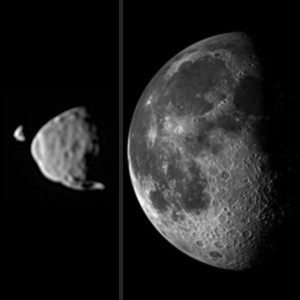Phobos and Deimos: Two Moons Passing in Martian Night Caught on Camera [VIDEO]

NASA's Curiosity Rover on Mars has sent back images that show the Red Planet's larger moon passing its smaller satellite during a Martian night.
Mars has two moons - Phobos and Deimos - and in this video (made from still images taken by Curiosity) NASA reveals Phobos passing directly in front of its smaller cousin.
NASA photos also show large craters on Phobos' surface [as seen by the Rover on Mars' surface]. The images were recorded by the telephoto-lens camera of Curiosity's two-camera Mast Camera (Mastcam) instrument on 1 August, providing more precise knowledge of the moons' orbits to the scientists.
"The ultimate goal is to improve orbit knowledge enough that we can improve the measurement of the tides Phobos raises on the Martian solid surface, giving knowledge of the Martian interior. We may also get data good enough to detect density variations within Phobos and to determine if Deimos' orbit is systematically changing," said Mark Lemmon of Texas A&M University, who is also a co-investigator for use of Mastcam.
According to scientists, the images suggest that the orbit of Phobos is gradually getting closer to Mars while Deimos' orbit may be slowly getting farther from the planet.
Phobos' diameter is one percent less than that of the Earth's Moon. It orbits much closer to its planet than the Moon does.
"As seen from the surface of Mars, Phobos looks about half as wide as what Earth's moon looks like to viewers on Earth," Nasa said in a statement.
Check out the video below showing the two moons of Mars passing in a Martian night.
© Copyright IBTimes 2025. All rights reserved.






















